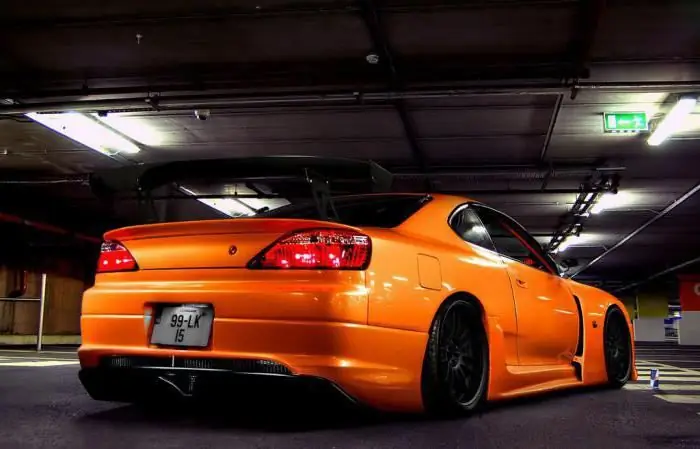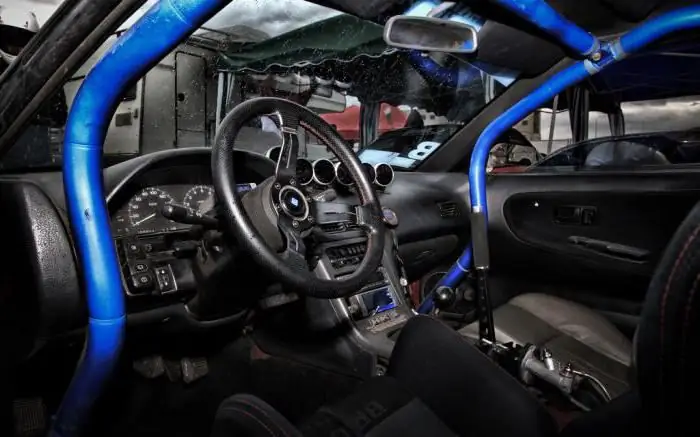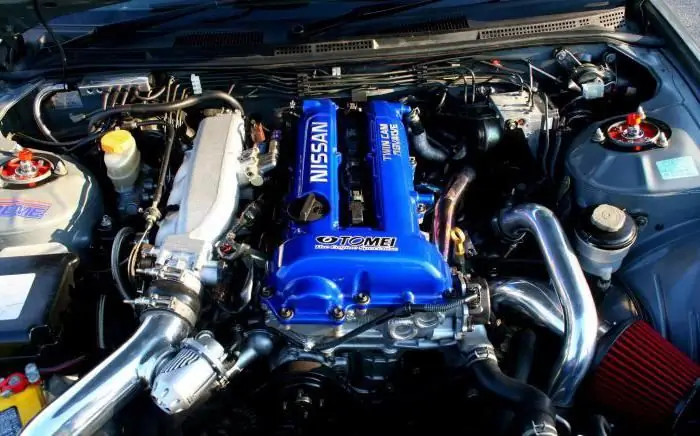2025 Author: Erin Ralphs | [email protected]. Last modified: 2025-01-22 21:14:18
"Nissan Silvia" is a passenger car owned by the Japanese world-famous concern. Throughout the years of production, this model was equipped with a variety of four-cylinder engines with DOHC gas distribution. And this is not the only feature that distinguishes this car.

The 1964-1968 issue is one of a kind
The first thing to note is the 1st generation. And this is the Nissan Silvia, produced in the back of the CSP 311. His debut took place in 1964 in Tokyo. The car was assembled by hand, based on the Fairlady coupe. A powerful 1.6-liter engine from Nissan was installed in this car. In 1968, production ceased. For the entire period, only 544 cars were produced. And each of them boasted a unique hand-molded body panels. Many cars remained in Japan, but still 49 cars were exported to Australia, and then ten more to other countries. It is not necessary to specify why so few cars were produced - the phrase "hand-built" says it all.
1975-1983 Issues
Following the first generationcame the second, and then the third. Representatives of the 1975-1979 production had an S 10 body. It could be recognized by more traditional lines: calm, classic, flowing, creating a pleasant image, in contrast to the cars produced at that time by Mazda and Toyota. In terms of exterior design, Nissan has stepped further than its competitors. The cars were equipped with 4-cylinder engines. Also, manufacturers endowed their works of auto-art with both 4-speed mechanics and a 3-speed automatic. By the way, these cars were very light, there was not even a ton of weight in them.
The third generation of the Nissan Silvia was more successful than the previous two. It was produced in the back of a three-door hatchback and a two-door coupe. It was originally planned to install a rotary engine there, but it did not pass the quality test, and therefore was replaced by a Z20, an ordinary piston engine. But in the early 80s, the concern released a “charged” version of the Nissan Silvia. It was a coupe with a 2.4-liter engine.

Pre-1995 issue
The Nissan Silvia became more and more popular. Photos of cars produced at that time show us pretty good models made in a good classic design. But the fourth and fifth generations boasted more modern machines. Nissan Silvia of those years has undergone great changes both in terms of appearance and in terms of technical characteristics. Now the car was equipped with engines, the volume of which began with 1.8 liters, and ended with three. The machine has becomefour-speed, and the mechanics acquired five speeds.
The fifth generation has become even more modern. The cars got fixed headlights, a multi-link rear suspension and even a limited slip differential.

Latest generations
From 1995 to 2002, Nissan produced cars that are representatives of the sixth and seventh generations. These are really modern and stylish models. They feature a new rounded design, and the cars are much wider and lower. And the wheelbase has also increased. Due to this, handling has become much better. In 1996, the car was made more aggressive, added to its sporty character. Front and rear lights, fenders, hood, bumpers, grille - all this has also become more attractive.
And the representatives of the seventh (last) generation completely stunned everyone on the spot. It was a brand new car with a 250 hp engine. With.! Modern style, fashionably designed interior, six-speed mechanics - such a car simply could not help but become popular. It was the seventh generation models that were exported the most. Because it's a really good car.
Recommended:
Nissan company: success story

Nissan's history is a successful and eventful journey to worldwide recognition. The Japanese firm, very small, went through a process of absorption, acquisition and cooperation before becoming the largest auto concern
The story of a legend and the revival of the iconic Volkswagen Hippie

The car, which can be safely called a symbol of the era, is still of great value to the older generation. As soon as they did not call the "Volkswagen Hippie" for the entire time of its existence, but in history it will forever remain as a car symbolizing freedom, love and travel. However, everything that characterized the hippie subculture. Read about the history of the legendary car in our today's article
"Mazda Bongo" - a story through generations

For the first time, the Mazda Bongo minivan was born back in 1966. At that time, it was a rear-wheel drive car with very modest technical characteristics for today. The machine was equipped with a small gasoline engine brand F800 with a displacement of 0.782 liters. Some time later, Japanese engineers launched a new Mazda Bongo minivan with one-liter F1000 engines into mass production
The best seven-seat cars. All brands of seven-seat cars

More recently, buying a car for the whole family, especially if it is large, was quite problematic. Nowadays, seven-seater cars that are designed for the whole family are gaining popularity. What cars from this series are worthy of attention? Which vehicle of this type is worth buying? The answers to these and other questions will be given in the article
The story of an ordinary Japanese: "Toyota Corsa"

Time passes, things change. So it is with cars: many great models simply disappear. Such a fate overtook the Toyota Corsa

